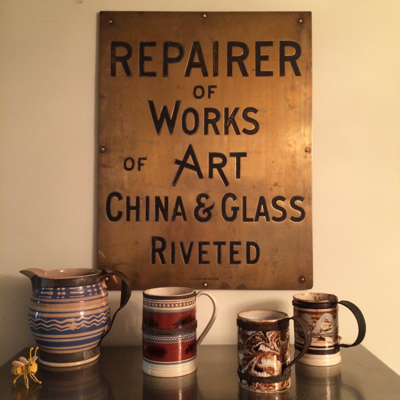After a brief break from posting, I am back with more to share from my collection of antiques with inventive repairs.
Last weekend, the nearly 300 pieces from my collection, on loan to Boscobel for the exhibit Make-Do’s: Curiously Repaired Antiques, were returned to me. I was without them for almost a year and during that time, the suddenly empty shelves in my office slowly filled up with books and other household items. Due to time restraints, rather than methodically return the hundreds of teapots, jugs, plates, cups, goblets, etc. to my shelves in an orderly fashion, I was just able to pile them up all around the house, praying that my 2 young cats, Grady and Oscar, wouldn’t turn my prized repaired pieces back into broken antiques. As I have said before, there’s nothing more redundant than a broken make-do. So far, I am happy to report that everything is still intact!
Looking ahead, I may not be posting every week as I have for the past nearly 7 years, so please be patient with me between lapses in my posts. I have some exciting new projects I am working on and will share the results in the near future. Thank you for following my blog, which continues to bring me great pleasure, as I acquire and research new pieces and write these posts.

I’ve missed your blog, though I saw the marvelous presentation at Boscobel (a discovery in itself).
Please start your renewed communication by explaining the origin (UK?) and date of the brass shop sign. Until how recently was riveting offered as a method of repair in Europe and the US?
Welcome back, Andrew. I’ve missed you and am delighted that you’re posting again. I look forward to following your fascinating adventures!
Always happy when you make an appearance! Life interferes with the virtual world — as it should. That sign is so perfect – as if it was custom made for you. What a find!
Glad to see you’re back. Understand your busy real life pursuits. But love your postings and eagerly look forward to any you have time for.
Thank you Louise, Nancy, Susan, and Diane!
To briefly answer your question, Louise…I believe the brass sign is from a shop in NYC and most likely dates to the late 1800s-early 1900s. Staple repair started to decline in the US soon after WW2, with the invention of new adhesives, enabling people to glue their own broken ceramics and glassware. Staple repair continued into the early 1960s more in the in the UK than in the US.